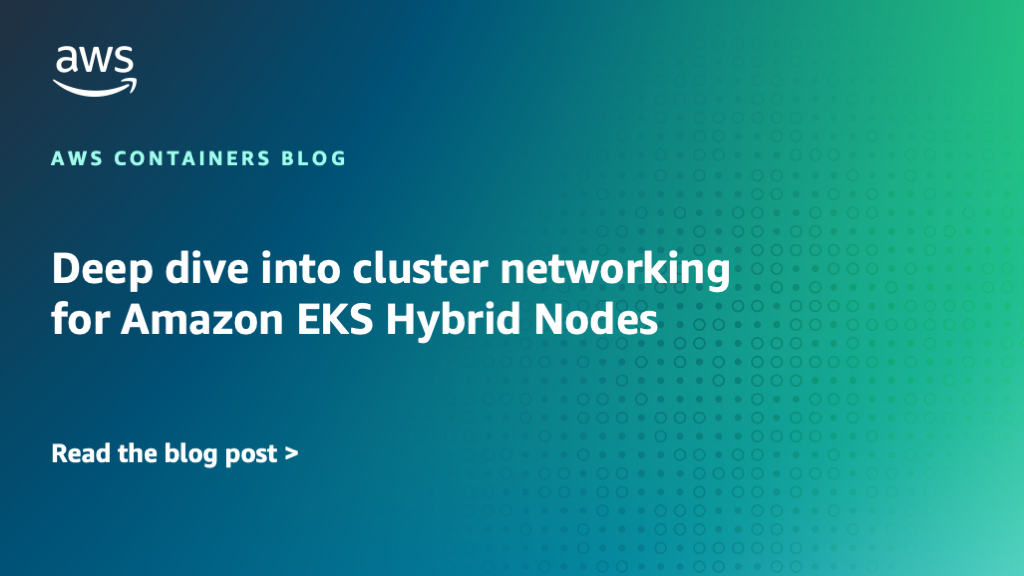Containers
Tag: networking
Deep dive into cluster networking for Amazon EKS Hybrid Nodes
In this post, we dive deep into cluster networking configurations for Amazon EKS Hybrid Nodes, exploring different Container Network Interface (CNI) options and load balancing solutions to meet various networking requirements. The post demonstrates how to implement BGP routing with Cilium CNI, static routing with Calico CNI, and set up both on-premises load balancing using MetalLB and external load balancing using AWS Load Balancer Controller.
Migrating from AWS App Mesh to Amazon VPC Lattice
After careful consideration, we have made the decision to discontinue AWS App Mesh, effective September 30th, 2026. Until this date, existing AWS App Mesh customers will be able to use the service as normal, including creating new resources and onboarding new accounts via the AWS CLI and AWS CloudFormation. Additionally, AWS will continue to provide […]
Enabling mTLS with ALB in Amazon EKS
Introduction In today’s interconnected world, communication faces evolving security threats. From sensitive financial transactions in online banking to secure data transmissions in the automobile industry, ensuring trust and authenticity between businesses is becoming more and more critical. This is where Mutual Transport Layer Security (mTLS) can be an option to offer enhanced security through advanced […]
The journey to IPv6 on Amazon EKS: Interoperability scenarios (Part 3)
Introduction So far, in Part 1 and Part 2 of this blog series we covered the foundational aspects of Amazon Elastic Kubernetes Service (Amazon EKS) IPv6 clusters and highlighted key patterns for implementing IPv6 to future-proof your networks. Besides configuring your IPv6 Amazon EKS clusters, migration to the world of IPv6 involves careful infrastructure planning […]
The journey to IPv6 on Amazon EKS: Implementation patterns (Part 2)
Introduction In Part 1 of this blog series we covered the foundation of Amazon Elastic Kubernetes Service (Amazon EKS) IPv6 clusters and the deep integration into the underlying Amazon Virtual Private Cloud (Amazon VPC) dual-stack IP mode. As customers evaluate their migration strategies to IPv6 to harness the benefits of scale and simplicity, they need […]
The Journey to IPv6 on Amazon EKS: Foundation (Part 1)
Introduction Scaling Kubernetes networking is key to addressing the growth of services and future-proofing infrastructure as the digital landscape continues to evolve. The need for a unique IP address per pod intersects with the challenges of limited IPv4 address space. The finite pool of available IPv4 addresses often forces Kubernetes cluster administrators to use alternatives […]
Spark on Amazon EKS networking – Part 2
This post was co-authored by James Fogel, Staff Software Engineer on the Cloud Architecture Team at Pinterest Part 2: Spark on EKS network design at scale Introduction In this two-part series, my counterpart, James Fogel (Staff Cloud Architect at Pinterest), and I share Pinterest’s journey designing and implementing their networking topology for running large-scale Spark […]
Spark on Amazon EKS networking – Part 1
This post was co-authored by James Fogel, Staff Software Engineer on the Cloud Architecture Team at Pinterest Part 1: Design process for Amazon EKS networking at scale Introduction Pinterest is a platform that helps inspire people to live a life they love. Big data and machine learning (ML) are core to Pinterest’s platform and product, […]
Securing API endpoints using Amazon API Gateway and Amazon VPC Lattice
Introduction In microservices architectures, teams often build and manage internal applications that they expose as private API endpoints and publicly expose those endpoints through a centralized API gateway where security protections are centrally managed. These API endpoints allow both internal and external users to leverage the functionality of those applications. The separation of concerns between […]
Implement AWS IAM authentication with Amazon VPC Lattice and Amazon EKS
Introduction Amazon VPC Lattice is a fully managed application networking service built directly into the AWS network infrastructure that you use to connect, secure, and monitor all of your services across multiple accounts and virtual private clouds (VPCs). With Amazon Elastic Kubernetes Service (Amazon EKS), customers can use Amazon VPC Lattice through the use of […]









